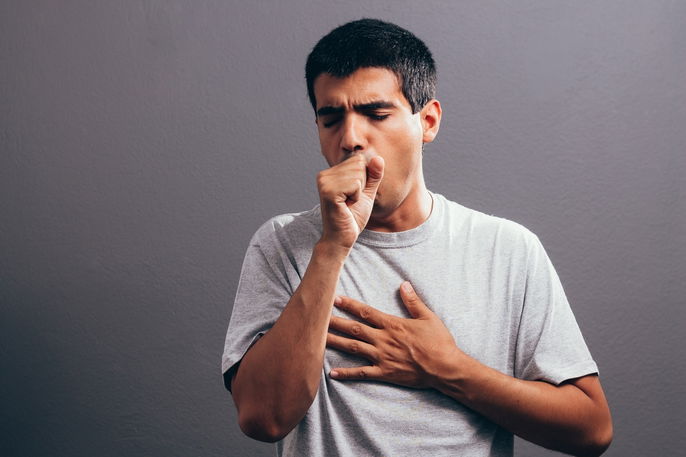White phlegm is generally a sign of respiratory infections or inflammation (like bronchitis or sinusitis ) and lung diseases (like COPD). It may also be caused by digestive issues, like acid reflux or a food allergy.
Normally when phlegm is produced, it traps any bacteria, fungus or viruses along the respiratory tract to be eliminated through coughs. It is a protective mechanism of the respiratory system. Phlegm is also made up of antibodies, which are proteins that help to protect the body from microorganisms.
If you frequently notice white phlegm and/or if it presents with symptoms like fever, headache or fatigue, you should see your doctor assessment to identify the cause and start appropriate treatment.

What does white mucus mean?
White phlegm is caused by:
1. Sinusitis
White phlegm can be produced with sinusitis, which is an inflammation that affects that sinus cavities in the nose, eyes and cheeks areas. This condition can last for 4 to 12 weeks. In addition to white phlegm, you may also experience fever, pressure within the ears, fatigue, runny nose and bad breath. Learn about the sinusitis medication that may be prescribed for treatment.
How to treat: To help eliminate or cough out the phlegm, you are advised to drink at least 2 L of water per day. This can help prevent dryness, which makes phlegm elimination more difficult. To treat the sinusitis, you should see your doctor, who may recommend nasal irrigation, analgesics for pain, antibiotics or decongestants. Read more about natural treatments for sinusitis that you can try at home to complement your medical treatment.
2. Acute bronchitis
With acute bronchitis, phlegm may be clear or white and is produced due to inflammation within the bronchi. The bronchi are responsible for delivery oxygen to the lungs. This condition can last for about one month, and is associated with symptoms like cough with white phlegm, which can worsen at night, fatigue, wheezing and chest pain.
How to treat: To treat bronchitis, it is important to see your doctor for assessment. He or she will evaluate your symptoms and may prescribe medication like acetaminophen for pain, or a bronchodilating inhaler to improve breathing. In addition to medication, you should drink plenty of water and hot drinks, like teas. This will help to improve breathing and relieve associated symptoms.
3. Asthma
Asthma is a chronic lung inflammation that can lead to the production of white phlegm. Asthma is a genetic illness that emerges during childhood. Factors like obesity or exposure to dust or perfume can worsen symptoms, which may include shortness of breath, coughing, chest tightness and wheezing.
How to treat: To treat asthma, you should be assessed by a doctor who will formulate the best treatment plan for. you. Treatment for asthma usually involves the use of steroids and inhalers - learn more about the asthma medication your doctor may prescribe. You should avoid polluted environments, animal fur and cleaning products. Smoking can also worsen this condition, and therefore patients are advised to quit.
4. Acid reflux
Acid reflux is a condition in which stomach acid back-up into the esophagus or mouth. It can be caused by obesity or age, and the main symptoms include burning, coughing with white phlegm, hoarseness, and tooth decay. Learn more about the symptoms and causes of acid reflux.
How to treat: It is important to consult your doctor or gastroenterologist to confirm a diagnosis and start appropriate treatment. The doctor may prescribe medication to reduce acid production in the stomach, like omeprazole. Check out other home remedies for acid reflux that you can incorporate with your medical treatment.
You should also avoid alcohol, smoking and using tight clothing. A GERD diet as recommended and monitored by a registered dietitian may also relieve your symptoms.
5. Food allergy
A food allergy is a system reaction that the body has to some foods, like peanuts, milk, eggs, seafood, wheat or soy. Symptoms emerge within 20 minutes to 2 hours of eating the food, and can vary from person to person. Common symptoms include itching, skin blisters, coughing with white phlegm, nausea, and vomiting. Serious allergies can induce anaphylactic shock, which can lead to decreased blood pressure, swelling of the lips and difficulty breathing.
How to treat: To treat a mild allergy, you should see your doctor or an allergy specialist to confirm the allergy. Treatment may involve the use of a nebulizer, anti-histamine or steroids.
If you experience more serious symptoms, like shortness of breath or a swollen throat, you should call an ambulance or proceed to the hospital immediately. A medical assessment is essential to identify the trigger, which should be eliminated from the diet to prevent further reactions.
6. COPD
Chronic obstructive pulmonary disease, or COPD, is a chronic illness that occurs to prolonged exposure to smoke, dust or other irritating substances. It causes the respiratory airways to narrow, which gradually impacts air circulation to the lungs. Common symptoms include difficulty breathing, coughing and excessive phlegm production (which can be white or other colors).
How to treat: You should be assessed by a lung specialist if you suspect you have COPD. Treatment will vary by the severity of the condition. Patients are advised to quit smoking, and may be prescribed medication like inhalers and steroids. Oxygen therapy, physiotherapy and physical activity may also help relieve symptoms. A balanced diet as recommended by a registered dietitian is also beneficial.






























